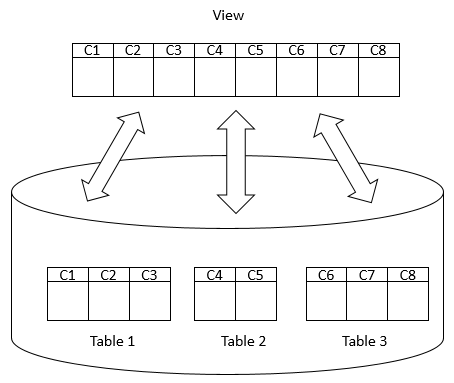- 자주 조회사는 Query를 View로 만들어 두면 사용하기 편리하다.
- 만들어진 View는 Table조회 하는것과 같이 사용할 수 있다.
- 보안, 간략함, 일관성을 유지 할 수 있다.
- Join과 Group을 이용하여 여러Table의 정보를 하나의 View로 만들수 있다.
SQL Server Views
Summary: in this tutorial, you will learn about views and how to manage views such as creating a new view, removing a view, and updating data of the underlying tables through a view.
When you use the SELECT statement to query data from one or more tables, you get a result set.
For example, the following statement returns the product name, brand, and list price of all products from the products and brands tables:
SELECT product_name, brand_name, list_price FROM production.products p INNER JOIN production.brands b ON b.brand_id = p.brand_id;
Code language: SQL (Structured Query Language) (sql)
Next time, if you want to get the same result set, you can save this query into a text file, open it, and execute it again.
SQL Server provides a better way to save this query in the database catalog through a view.
A view is a named query stored in the database catalog that allows you to refer to it later.
So the query above can be stored as a view using the CREATE VIEW statement as follows:
CREATE VIEW sales.product_info AS SELECT product_name, brand_name, list_price FROM production.products p INNER JOIN production.brands b ON b.brand_id = p.brand_id;
Code language: SQL (Structured Query Language) (sql)
Later, you can reference to the view in the SELECT statement like a table as follows:
SELECT * FROM sales.product_info;
Code language: SQL (Structured Query Language) (sql)
When receiving this query, SQL Server executes the following query:
SELECT * FROM ( SELECT product_name, brand_name, list_price FROM production.products p INNER JOIN production.brands b ON b.brand_id = p.brand_id; );
Code language: SQL (Structured Query Language) (sql)
By definition, views do not store data except for indexed views.
A view may consist of columns from multiple tables using joins or just a subset of columns of a single table. This makes views useful for abstracting or hiding complex queries.
The following picture illustrates a view that includes columns from multiple tables:

Advantages of views
Generally speaking, views provide the following advantages:
Security
You can restrict users to access directly to a table and allow them to access a subset of data via views.
For example, you can allow users to access customer name, phone, email via a view but restrict them to access the bank account and other sensitive information.
Simplicity
A relational database may have many tables with complex relationships e.g., one-to-one and one-to-many that make it difficult to navigate.
However, you can simplify the complex queries with joins and conditions using a set of views.
Consistency
Sometimes, you need to write a complex formula or logic in every query.
To make it consistent, you can hide the complex queries logic and calculations in views.
Once views are defined, you can reference the logic from the views rather than rewriting it in separate queries.
'ForBeginner' 카테고리의 다른 글
| 4-5. Kepware의 장점. (0) | 2021.05.22 |
|---|---|
| 8-9.Database mail (0) | 2021.05.20 |
| 8-6. Linked Server (Good, bad and OPENQUERY) (0) | 2021.05.20 |
| 2-5. Sensor와 PLC의 연결 (0) | 2021.05.19 |
| 2-0. 왜 Sensor의 이해가 필요한가? (0) | 2021.05.19 |